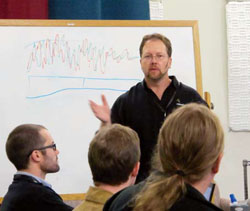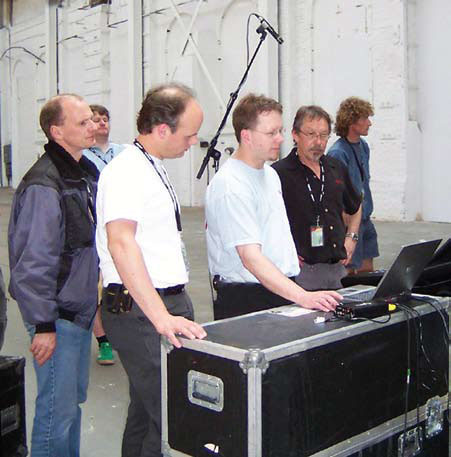
It All Comes Back
After graduating from WPI in 1988, Anderson realized his raw qualifications equipped him for a career he wasn’t terribly interested in. “I did some job interviews, mainly for military contractors.
As soon as I found the program at Yale, I pushed for that.” His parents were supportive, he says. “But it’s funny when you graduate and they say, ‘hey, what are you going to do with your engineering degree?’
And I say, ‘I’m going to get my MFA .’ They didn’t even blink. That was pretty cool.”
At Yale, one day while tweaking a sound system for a project, he found the time he’d spent with Pearson and Healy coming back.
“We had all these problems with the system, and it just hit me when I went out into the room to listen that this was what they were talking about.”
For his master’s thesis topic, Anderson chose “Equalization for Sound System Response Optimization” and began looking for readers, ultimately developing a relationship with Alexander “Thorny” Yuill-Thornton and through him, Bob McCarthy.
After graduating, Anderson spent a year at the University of Southern California before McCarthy offered him the opportunity to work with the Meyer Sound SIM (Source Independent Measurement) department.
He jumped on it. Calling Meyer Sound to make arrangements, little did he know that the voice on the other end of the phone belonged to his future wife and business partner.
“I was working as a master electrician at US C and mentioned that somebody had dumped a can of Coke in the lighting board, and because Karen comes from a theatre background as well, she started talking about the product knowledgably.” It was love at first geek, and the two married in 1995.
In short order, Anderson was working primarily in live concert sound, including serving as a systems tech for the Montreux Jazz and Telluride Bluegrass festivals. “I like live sound because it’s on a clock,” he says.
“You have to prioritize and make decisions. You have to do similar things in installations – design the system, choose the equipment and put it in the right place – but in a touring situation it’s a more compact schedule.”
He was also on the road regularly with the likes Anita Baker, k.d. lang, Louis Miguel, and, by 1995, Ultrasound and the Grateful Dead.
“It was great, but it got to the point where my job as a technical support manager never stopped. I’d come back to a pile of stuff on my desk and think it would be better just to do this full time.”

